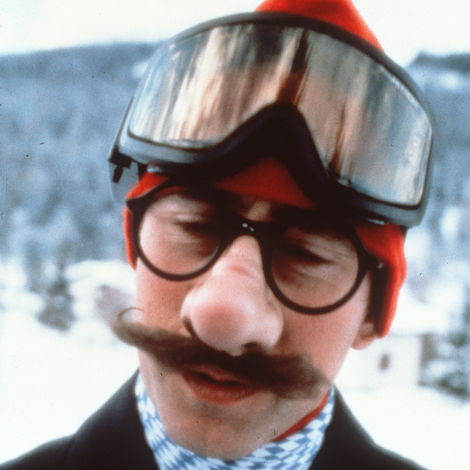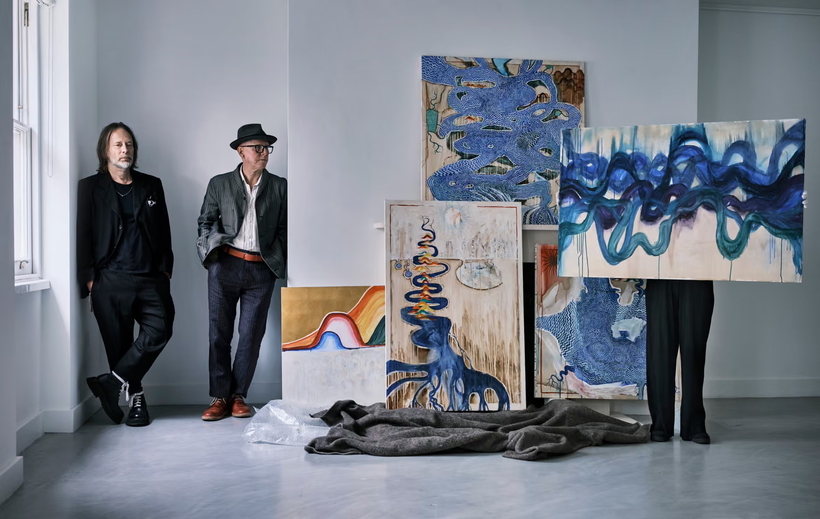Every college town nurtures its own hothouse music subculture, and the venerable university halls of Oxford, England, are no exception. During the 1990s Brit-pop era, the “Oxford scene” saw bands such as the chirpy retro-pop trio Supergrass and the dreamy “shoegaze” outfit Ride making waves nationally. But no band emerged with the same impact as Radiohead. Art-rockers whose members got together while pupils at an expensive private school in Abingdon (a small town a few miles south of Oxford), they debuted in 1986 under their original name, On a Friday, at Oxford’s legendarily scuzzy music venue, the Jericho Tavern.

So it’s a homecoming, next Wednesday, when “This Is What You Get: Stanley Donwood, Radiohead, Thom Yorke” opens at Oxford’s Ashmolean Museum. Featuring the band’s original artwork—paintings for album covers, drawings, etchings, CD booklets, posters, and drafts of lyrics—the exhibition takes its title from a line in Radiohead’s haunting song “Karma Police.”
While the gallery is an august institution more accustomed to hosting the likes of Anselm Kiefer or Minoan archaeology, the band’s lead singer and main songwriter, Thom Yorke, is a conspicuous presence in the city. In 2016, after he donated a copy of William Blake’s Songs of Innocence and Experience to a local charity shop, it was discovered that he had scrawled Radiohead lyrics in the margins. The book brought $16,000 at auction.

The work on view at the Ashmolean is the product of a partnership. Yorke and Stanley Donwood (real name: Dan Rickwood) met while students at the University of Exeter; after graduating, Yorke rejoined the band in Oxford, and Donwood worked odd jobs to support his art practice. In 1993, when Radiohead’s debut album, Pablo Honey, was released, Yorke was disappointed with the accompanying images. In 1994, Donwood and Yorke began designing all of the band’s promotional materials.
Once Donwood gained Yorke’s confidence, he set up camp wherever Radiohead was recording. Their work together—which appears very “joint,” much of it constantly reworked, modified, or creatively defaced by each man in turn—reflects a restless, experimental spirit they share, from the blown-out digital-video stills on the cover of The Bends (1995), shot in the gloomy basement of Oxford’s Radcliffe Infirmary, where they’d found an iron lung, to the Artex-slathered snowscapes created for Kid A (2000), to the gesso-and-tempera concoctions put together for A Light for Attracting Attention, an album released in 2022 by Yorke’s side project, the Smile.

The question remains, naturally: Is it any good? Would Donwood have achieved an Ashmolean exhibition without the impetus of Radiohead’s cultural cachet? Is Yorke’s status as an era-defining musician the only reason why his art is taken so seriously? In truth it’s hard to tell, nor does it matter that much. The album cover is a notably difficult micro-genre to assess, largely determined by the impact of the music encased within it. (Rock photography is in the same position: Are the accomplishments of Mick Rock, Henry Diltz, et al. down to the undeniable charisma of the people they are pointing their cameras at?)

Some bands, such as the Beatles, with Peter Blake and Richard Hamilton, or Blur, with Banksy and Julian Opie, have squared the circle by commissioning previously established names. Others, such as the Stone Roses’ John Squire, did the same as Yorke by taking the matter into their own hands.

In the end it comes down to personal likes and dislikes, and your appreciation of the ragged, scrappy figuration that the Donwood–Yorke partnership does best. My favorites are the irradiated treescapes and glowing-eye creatures they made for Radiohead’s 2011 album King of Limbs, and Donwood’s black-and-white line drawings of flood and destruction for Yorke’s 2006 solo release, The Eraser. That one of those line drawings has been enlarged into a wall mural outside the XL record-company building in London is proof that even the most esoteric art, if it really works, can have a popular life.
“This Is What You Get” will go up at the Ashmolean Museum, in Oxford, England, from August 6, 2025, to January 11, 2026
Andrew Pulver writes about film for The Guardian and about art for The Art Newspaper. He lives in Oxford

